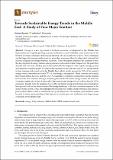| dc.contributor.author | Bayomi, Norhan | |
| dc.contributor.author | Fernandez, John | |
| dc.date.accessioned | 2020-03-24T14:49:58Z | |
| dc.date.available | 2020-03-24T14:49:58Z | |
| dc.date.issued | 2019-04-28 | |
| dc.date.submitted | 2019-02-21 | |
| dc.identifier.issn | 1996-1073 | |
| dc.identifier.uri | https://hdl.handle.net/1721.1/124226 | |
| dc.description.abstract | Energy is a key ingredient to facilitate economic development in the Middle East. Expectations for a rapidly growing economy in the next decade will likely cause an increase in the fraction of energy consumed domestically limiting what is available for export. These challenges are the biggest for resource-rich countries, since their economy is heavily dependent on fossil fuel exports alongside an energy-intensive economy. Thus, the paper addresses the question of how the development of energy systems among resource-rich countries has changed over the past three decades and what role can they play in the sustainable development of the region's energy system and emission reduction goals? To address this question, we present an overview on energy trends in four resource-rich countries in the Middle East, which nearly account for 76% of the region's energy-related emissions and about 77% of total energy consumption. These countries are namely, Iran, Saudi Arabia, Kuwait, and the UAE. Accordingly, we present a comparative energy analysis between the four countries through examining historical and current energy trends, the structure of energy supply, the status of renewable deployment and energy-related carbon dioxide (CO2) emissions. Results from the analysis showed that inefficient energy production and consumption have played a role in the deterioration of the energy landscape of the four countries compared to the global energy system. Thus, this highlights the necessity for suitable energy strategies and effective policies that will be central to sustainable energy development. The analysis presented here could be used to better understanding of the impacts of current gaps and inefficiencies in large energy consumers in the Middle East. Keywords: energy; CO[subscript 2] emissions; Middle East; STEEP analysis; fossil fuels | en_US |
| dc.language.iso | en | |
| dc.publisher | MDPI AG | en_US |
| dc.relation.isversionof | 10.3390/en12091615 | en_US |
| dc.rights | Creative Commons Attribution 4.0 International license | en_US |
| dc.rights.uri | https://creativecommons.org/licenses/by/4.0/ | en_US |
| dc.source | MDPI | en_US |
| dc.title | Towards sustainable energy trends in the Middle East: A study of four major emitters | en_US |
| dc.type | Article | en_US |
| dc.identifier.citation | Bayomi, Northan and John E. Fernandez. "Towards sustainable energy trends in the Middle East: A study of four major emitters." Energies 12, 9 (April 2019): 1615. © 2019 by the authors | en_US |
| dc.contributor.department | Massachusetts Institute of Technology. Building Technology Group | en_US |
| dc.contributor.department | Massachusetts Institute of Technology. Department of Architecture | en_US |
| dc.relation.journal | Energies | en_US |
| dc.eprint.version | Final published version | en_US |
| dc.type.uri | http://purl.org/eprint/type/JournalArticle | en_US |
| eprint.status | http://purl.org/eprint/status/PeerReviewed | en_US |
| dc.date.updated | 2019-08-05T15:42:23Z | |
| dspace.date.submission | 2019-08-05T15:42:26Z | |
| mit.journal.volume | 12 | en_US |
| mit.journal.issue | 9 | en_US |
| mit.metadata.status | Complete | |
